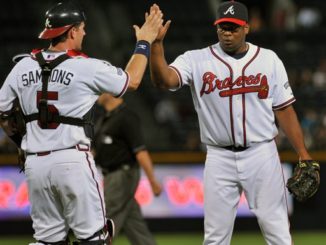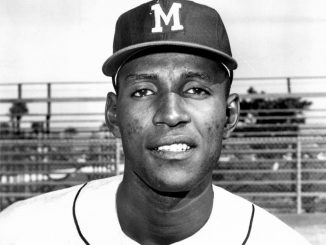 See also: Best Brave By Uniform Number Index
See also: Best Brave By Uniform Number Index
Quick, who threw the first World Series pitch in Atlanta Braves history? Maybe you’ll know that the first World Series team in Atlanta Braves history was the 1991 worst-to-first Braves. It was a pretty great team, after all. If you know that team well, you’d probably guess Tom Glavine threw that first World Series pitch. He won the 1991 NL Cy Young Award, but it wasn’t him. Ok, how about NLCS MVP Steve Avery? Nope. Another of the young guns, John Smoltz? Still no.
For Game 1, Bobby Cox turned to the veteran crafty lefty on staff, the only starter with a World Series ring, won with the 1985 Royals. He turned to the best Brave to ever wear #32, Charlie Leibrandt.
Leibrandt debuted in 1979 with the Reds, and he joined Cincy’s rotation the following year (10-9, 4.25). 1981 saw him return to AAA. He returned to Cincinnati in 1982, pitching mostly from the ‘pen, and pitching poorly. He didn’t break camp with the team in ’83, and while in AAA was traded to Kansas City. In 1984, the now 27 year old worked his way back into the majors, joining the Royals rotation, and he suddenly excelled (11-7, 3.63). 1985 would be his finest season, going 17-9, 2.69, finishing 5th in the AL CYA race. Leibrandt gave the Royals 16.1 innings in 2 games in the World Series, allowing a 2.76 ERA. Over the next 4 seasons with KC, Leibrandt was solid though unspectacular, going 48-45 with a 3.84 ERA.
After the 1989 season, Leibrandt was traded to Atlanta, and in 1990 brought competency to the Braves staff (9-11, 3.16), something of a foreign concept at the time. As a member of the ’91 Braves, Leibrandt remained reliable, going 15-13, 3.49. In his only NLCS start, he went 6 2/3, allowing 2 runs. Relatively fresh, Leibrandt was asked to start Game 1 of the 1991 World Series opposite Jack Morris. It didn’t go well, and Leibrandt was skipped for his next start, which… sadly made him available for bullpen duty. Cox brought him in the extra innings of Game 6, and Leibrandt threw his most infamous pitch:
Leibrandt was excellent again in 1992 (15-7, 3.36), and made 2 valuable relief appearances in the ’92 NLCS. After 1992, he was traded to Texas, where he struggled to a 4.55 ERA in 1993, his final MLB season.
Honorable Mentions
- Derek Lowe was probably worth the money Atlanta gave him, but it came at a time when we weren’t quite used to the $/WAR free agent scale. He got a bad rap for being overpaid, but Lowe provided a competitive team with quality innings.
- Earl Williams was the 1971 NL Rookie of the Year, hitting 33 HR. He was traded after two seasons to the Orioles for a bundle of players.
- Similar to Lowe, Braves fans remember Mike Hampton most for his time as a severely overpaid player. However, in 2003 and 2004, when Florida (a team he never pitched for) was bizarrely paying the bulk of his salary, Hampton was a pretty good starting pitcher, winning both a Gold Glove and a Silver Slugger with a 4.05 ERA in the last gasps of the steroid era.
Who Is the Best Ever To Wear #32?
Let’s take a second to honor our runner-up, Sandy Koufax:
Over the last 6 seasons of his career, he went 129-47 with a 2.19 ERA and 1713 K’s in 1635.2 innings. Granted, he was pitching in a pitcher’s park during the most favorable era to pitchers since the dead ball era, so I think it’s easy to overrated Koufax a bit. Still, he had a marvelous peak, statistically eye-popping to this day.
But the best #32 was another lefty, one who maybe never had a season quite like Koufax’s 1963 or 1965, but had a LOT of really great seasons. It’s the only man with 4000 K’s in NL history – Steve Carlton.
He won four Cy Young Awards and 329 games (11th). He pitched 5,217.2 innings, 9th most in MLB history. His 4136 K’s still rank 4th in MLB history. His 709 starts rank 6th. He’s the most productive #32 in history, and possibly thanks to Koufax’s elbow, it’s not close.




Leave a Reply